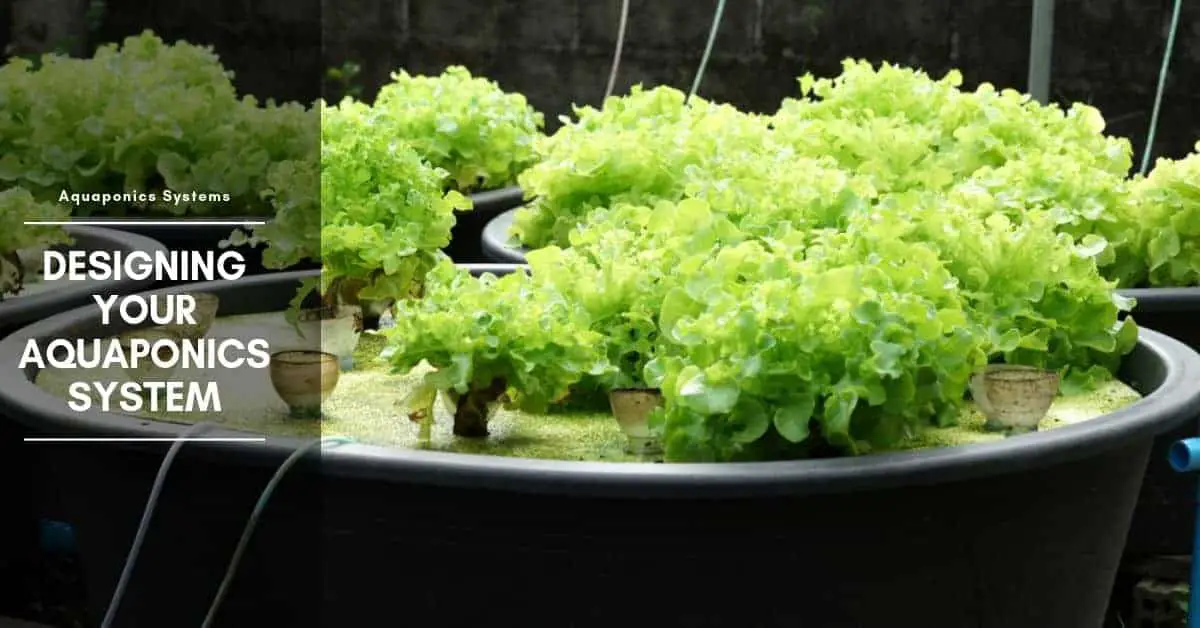There are many different types of aquaponic systems – this post covers just a few – and the system chosen will depend on your needs as well as the resources which you have available. There are many pre-fabricated units available for purchase, but it is also possible to construct your own. It all depends on budget and practical ability.
This post will give an indication of the environmental and practical factors to be considered when designing and locating an aquaponic system. Keep in mind that most growers will utilize elements from different systems in order to best meet their gardening needs.
A basic aquaponic fish tank design plan
Prior to considering the various system types, it is necessary to examine the basic design of an aquaponics unit. Generally speaking, units consist of two main components: a fish tank; and a grow bed for raising aquaponic plants.
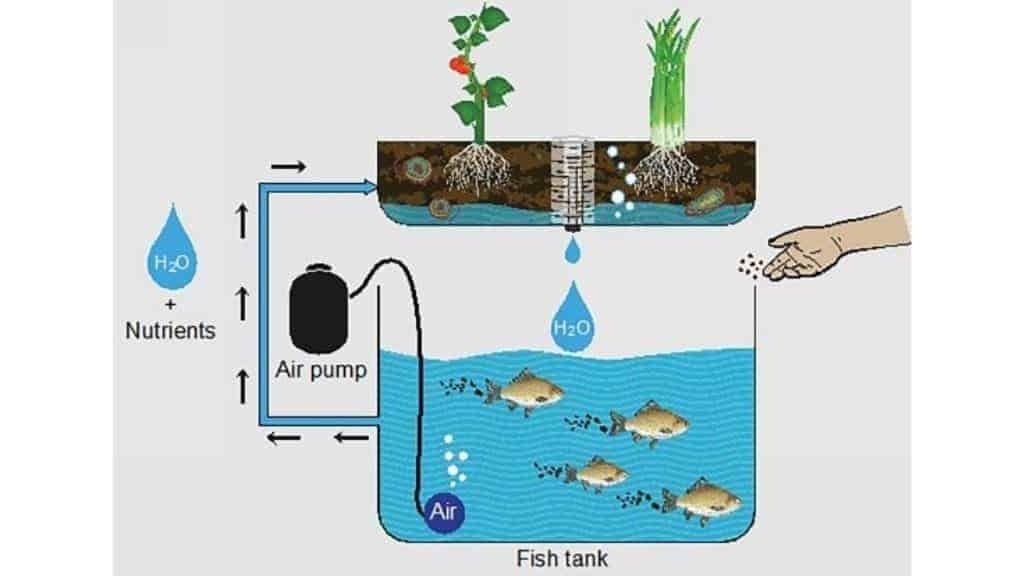
Some systems are more complex and may also include sumps, refugium or water reservoirs, bio-filters, sediment filters. And, of course, there are hundreds of different grow bed designs available to suit different spaces and plant types.
Ideal growing conditions to consider
When situating a garden or aquaponics fish tank, we take the needs and preferences of our plants or animals into account. However, with an aquaponics system, growing conditions are doubly complicated as the needs of plants, fish, bacteria, and their human guardians must be taken into account.
Sunlight
The plants in an aquaponic system have the same needs as any others – between 2 and 6 hours of sunlight per day, depending on the variety. However, the fish, bacteria, and any exposed water in an aquaponic system should be protected from sunlight.
Therefore, while it is vital to ensure sufficient light for robust plant growth, as much of the rest of the system as possible should be shaded or covered. In the case of situating a system under cover or indoors, artificial lights can be utilized as with hydroponics. However, similar precautions as with sunlight need to be taken to protect fish and bacteria and to prevent algae in exposed bodies of water.
Temperature
Although ambient temperature should also be considered, in particular with regard to maximum and minimum temperatures, realistically, it is water temperature that will be of most importance in an aquaponics system.
While plants are relatively hardy, fish and bacteria have very specific temperature requirements for optimum growth.
Some types of aquaponics fish are very susceptible to temperature fluctuations. It is for this reason that fish tanks should always be shaded and water temperature should be regularly monitored. Additionally, maximum and minimum temperatures need to be taken into account when choosing suitable fish varieties for your system. If possible, the system should be situated so that extreme fluctuations in temperature are unlikely.
The productivity of nitrifying bacteria is also affected by temperature. Although some processing will continue even at low temperatures, nitrification occurs most effectively between 60 and 85 degrees Fahrenheit (15-30oC) so in cool climates, systems will need protection from low temperatures.
Of course, because aquaponics runs on water, temperatures below freezing will not only affect the living creatures in the system but also have the potential to damage pumps and pipes.
Protection from the elements
Although sunlight and temperature are the primary concerns to be taken into account when locating an aquaponic system, protection from the elements should also be considered:
– Wind can have an impact on water temperatures and evaporation, and taller plants may also require some shelter for optimum growth.
– Rainfall can alter pH and nutrient levels in a system, so it is usually recommended that systems have some cover.
Space
Aquaponic systems can be extremely compact if necessary and are adaptable to all sorts of spaces. It is best, to begin with, a small system, and to allow yourself room to expand once you have perfected the system balance. The learning curve faced by the beginning grower can be steep, which becomes expensive in a massive system.
Location
An aquaponic system is much more complicated than a garden, and location can be the key to easy management. In choosing a location, in addition to the aforementioned considerations, you should also take into account that:
Aquaponic systems require daily monitoring
Choose somewhere convenient and accessible. If your unit is visible from your home, so much the better. Sometimes between 5 to around 10 minutes can be the difference between a loss of all of your fish, and their survival.
Electricity and water will be needed to run the system
Make sure you have running water and electricity present near your aquaponics growing location before starting to build your own aquaponic unit. Also, save some space for the needed locations for extra waste and nutrient storage.
Tetra AquaSafe Plus, 8.45 Ounces, aquarium Water Conditioner And Dechlorinator, Model Number: 46798162681 (Pack of 1)
$8.49 (as of October 20, 2024 08:04 GMT +03:00 - More infoProduct prices and availability are accurate as of the date/time indicated and are subject to change. Any price and availability information displayed on [relevant Amazon Site(s), as applicable] at the time of purchase will apply to the purchase of this product.)API STRESS COAT Aquarium Water Conditioner 4-Ounce Bottle (85B)
40% OffTetra 16172 AquaSafe Fish Tank Water Conditioner, 8.45 fl oz
39% OffSystems should be secure
Systems can be a hazard to small children and animals, as there are exposed cords, pumps, and bodies of water. Additionally, the plants and fish will require protection from predators, such as wild animals and domestic pets.
The best systems plans for aquaponic gardening from home
It is up to you to decide what type of aquaponic system best suits your needs as a gardener, as well as the space that you have available. All of the systems covered in this post are relatively easy to construct and function well on a home scale. The different systems have the same common elements, with different constructions or water cycles. This section considers the various systems available, including their strengths and uses, in order to help you make the choice that is right for you.
Flood and Drain Technique
Flood and Drain systems are a good starting point for the beginner and easy to manage on a home-scale. Plants are grown in a grow bed (or several) either situated directly above the fish tank or connected to a drain. The grow bed is flooded with water which then drains back to the tank.
Flood and Drain systems require minimum pumping power and the growing media contained in the beds makes the use of a sump or biofilter, and the related additional pumps, unnecessary in most home applications.
On the other hand, these systems are larger than other options, as they require horizontal space for the grow beds. Additionally, if the drain cycle is reliant on a bell-siphon, as is most common, there can be the risk of malfunction, leading to the emptying of the fish tank unless an emergency shut-off valve is installed.
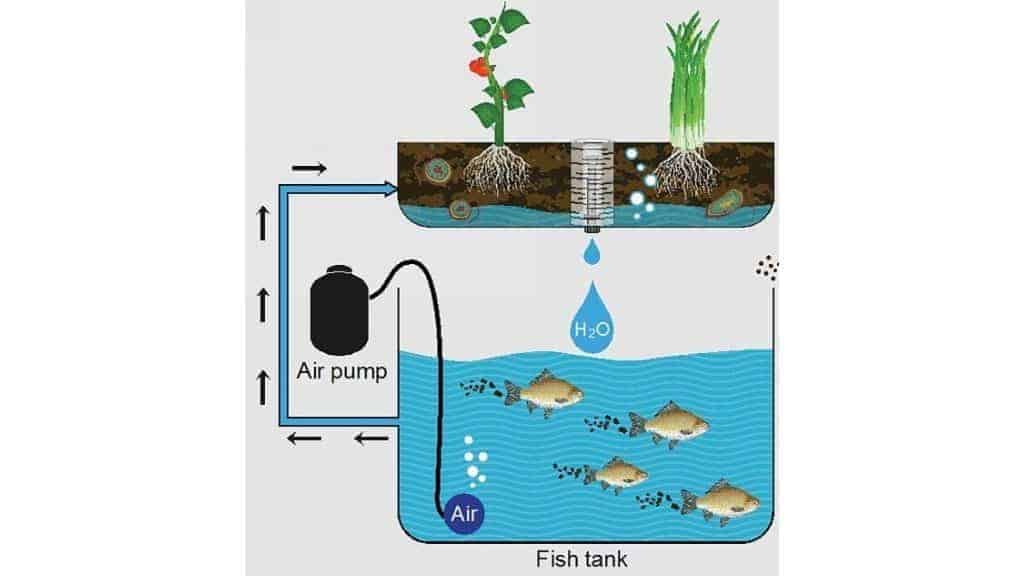
Nutrient Film Technique (NFT)
Nutrient Film Technique (NFT) is one of the most common growing methods used in conjunction with aquaponics. Plants are grown in tubes through which low-volume water is passed. Round tubes are commonly used, but square-bottomed tubes are best for larger plants like tomatoes and cucumbers.
This method is reliable and, due to the low water volumes, monitoring and trouble-shooting tend to be easier than with systems that utilize large volumes of water. NFT grow beds are light and well-suited to vertical arrangements, making them perfect for small spaces.
NFT systems are better suited to smaller plants and those which easily grow water roots, such as lettuces and herbs. Some larger plants like tomatoes can be successfully grown with a support structure, but those requiring a larger, more supportive root-base will not be suitable for NFT. Additionally, as NFT has little or no growing media, it requires the addition of a biofilter and a particle filter.
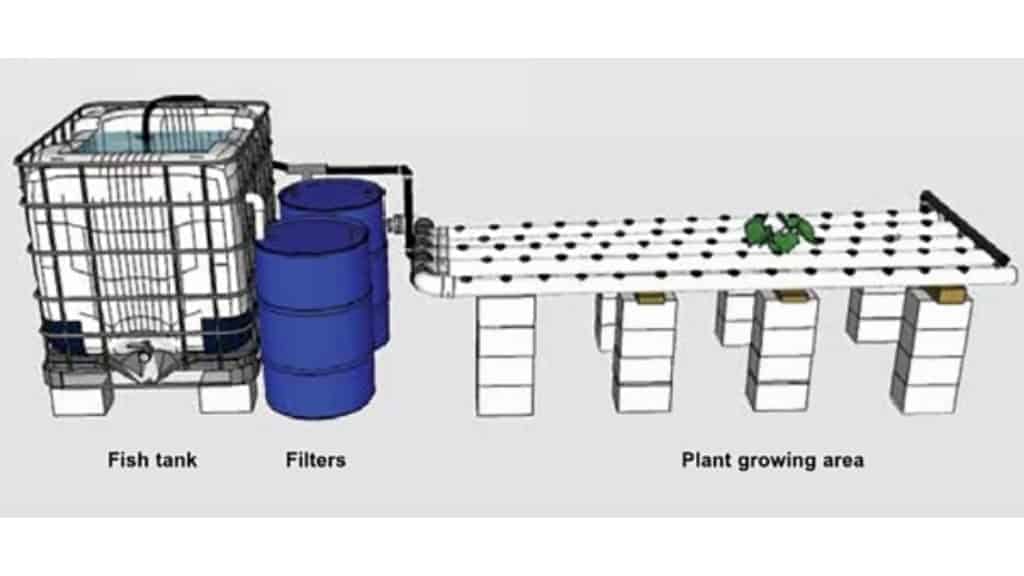
Media Bed Technique
Media Bed Technique is similar to NFT in that water is flushed through or past plants using gravity, however, rather than growing tubes, plants are cultivated in grow beds containing growing media.
As with NFT, the low volume of water used in Media Beds is an advantage for monitoring and troubleshooting. Additionally, Media Beds are well-suited to a greater variety of plants than NFT, because the growing media provides better root support. Growing media with a good surface area can negate the need for a biofilter in smaller systems.
Like Flood and Drain systems, Media Beds require sturdy frames and horizontal arrangement, making them less space-saving than some other systems.
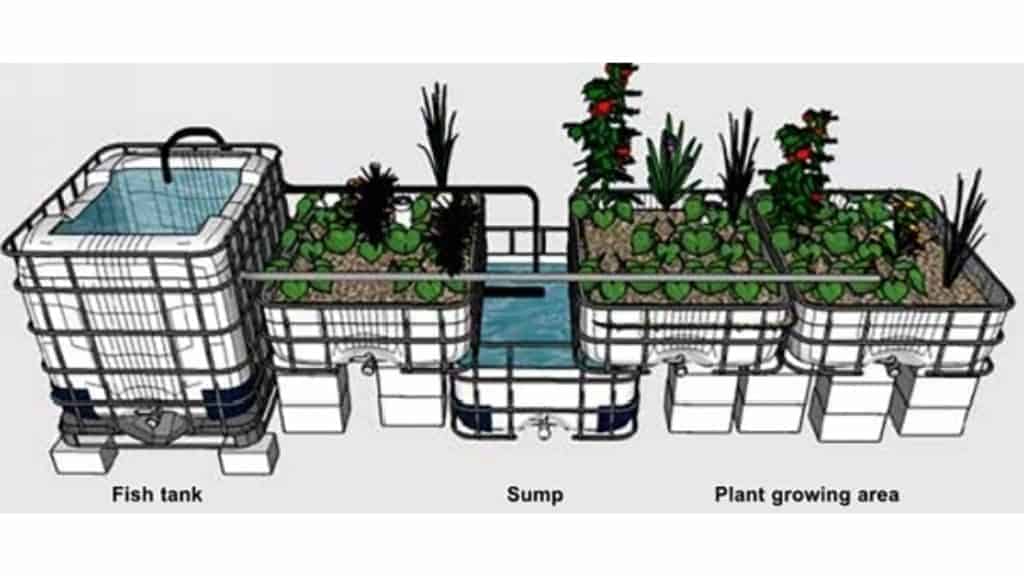
System parts and materials
System parts that are common to most aquaponic units include the following elements.
Growing trays
Your growing tray is where the plants grow, so the size chosen will depend on how much you want to grow and the type of system you are using. Base the size and the depth of the tray on plant-growth predictions and recommended pot depths. Trays should be no less than 3 inches deep (15cm). For larger fruiting plants such as peppers and tomatoes, trays should be at least 6 inches deep (30cm).
Plastic or metal are the longest-lasting materials for growing trays, although Styrofoam is sometimes used. In most systems, trays need to be sturdy as they may hold large amounts of water and heavy growing media. They should always be opaque.
Types of growing media
Soil is not used in aquaponic systems because it is not sterile, compacts in contact with water, and tends to clog filters and pumps.
In an NFT system, plants are grown directly in water. In most other aquaponic setups, a soil-less media is used. This growing medium, or substrate, is any material in which plant roots grow. There are many suitable growing media for use in aquaponics, but the main considerations are a media that does not degrade and contaminate the water, negatively affecting fish health and one that has plenty of surface area in order to promote the growth of nitrifying bacteria.
Keep in mind that all growing media should be well-washed before use to remove dirt and particles. If in doubt about media quality, cycle water through the media and test for pH and hardness.
Stone wool
Also known as mineral wool, stone wool is a felt-like material manufactured from molten rock. In its raw form, stone wool has a very high pH but treated varieties designed for hydroponics (e.g. Rockwool) are suitable for aquaponic systems. Stone wool is used in NFT systems to provide additional root support for larger plants such as tomatoes and cucumbers.
Gravel and limestone
Gravel and limestone are some of the more inexpensive growing media and provide plants with good root support. Some rocks have a tendency to leach minerals, so testing should be conducted prior to use.
The downfall of these growing media is that they do not retain water very well, are exceptionally heavy and are abrasive to handle. They are not as conducive to the growth of bacteria as other options, due to a low surface area to volume ratio, making a biofilter necessary.
Pumice and volcanic gravel
These volcanic minerals are light and provide good root support. They are riddled with holes and air-passages, like a sponge, so have a better surface area to volume ratio than actual rock, making them more conducive to bacterial growth.
Expanded clay beads
Expanded clay beads are a man-made equivalent to pumice and volcanic gravel. They are light, inert and retain water very well. They also have a very good surface area to volume ratio, encouraging beneficial bacteria. On the downside, clay beads are very expensive compared to other media and can be slightly fragile.
Cups and nets
The growing tubes used in NFT systems are often fitted with cups or nets. Plastic cups and nets are small plant holders that look a little like a small pot with an extra-wide lip. Homemade cups can be made from Styrofoam, plastic or mesh, as long as there are plenty of holes big enough to allow root growth but not so big that growing media will escape into the nutrient solution.
Pumps and fittings
One or several pumps may be needed to cycle water in an aquaponic system. Most system designs utilize a pump for irrigating grow beds and gravity feeds for drainage. There is no “right” system design. It all depends on your needs.
Choosing a pump
There are many pumps available that are suitable for a backyard aquaponics unit. For a relatively small system, a water feature (fountain) pump or pond pump is usually the most economical choice and will run on mains power. Your pump must be submersible and should have an in-built filter.
The size of the pump you choose will depend on how far you need water to travel, and how much water you want to pump per hour. Stronger pumps are more expensive but can be used to run more than one system if you have some plumbing expertise.
Pumps will list a pumping height and a maximum flow per hour. You should try to choose a pump that has a pumping height of at least a foot (30cm) higher than your system requirements in order to ensure a good flow of water. Unfortunately, regardless of the stats given, maximum flow is not achieved at maximum pumping height, so allow for this in your calculations.
You also need to consider the amount of water you wish to pump per hour. Most systems require only low water volumes; as even small pumps have adjustable capacities of at least 30 gallons (100L), maximum capacity is not usually of concern except in very large systems.
Fittings and installation
Depending on the design of your system, you may require T-joins or drip irrigation fittings such as taps, perforated hose, micro-bubblers or end-plugs in order to ensure the even distribution of water in your growing tray. Note that water will not dispense evenly from more than one outlet unless the hose connecting the outlets is completely level, so care must be taken in construction.
Remember that pumps will burn-out if left to run dry. Check systems frequently and ensure that the pump NEVER has less than 4 inches (10cm) of head space (water above it).
Air-pumps
Depending on the size of your unit, you will also require several air-pumps. These usually take the form of some type of aquarium pump, and the more modern air-stones are particularly effective. Installing two pumps in your fish tank and another in your biofilter is usually good practice.
System design considerations
Although the numerous aquaponics system designs have shared elements, such as grow beds, fish tanks, and pumps, there are also various features which can be fitted to systems as needed. Some key elements that might be included in the design of an aquaponic system are:
Sediment filters
Solid fish waste and uneaten food, as well as plant matter, will contaminate the water in an aquaponic system. Therefore, sediment filters, which remove solid waste, are a necessary part of most aquaponic units.
In Media Beds and Flood and Drain systems, growing media will act as a sediment filter, removing and storing any solid waste that passes through. However, using this method of sediment filtration alone can cause disease and lead to anaerobic conditions, inhibiting beneficial bacteria. At the very least, screens should also be used.
The simplest method of sediment filtration is fitting pipes, particularly those leaving fish tanks and grow beds, with a filter such as a mesh sieve or screen. Sediment will become trapped in the filter due to the pressure of passing water. This method requires the regular cleaning of the filter and is most suitable for small, lightly-stocked systems.
On a larger scale, water leaving the fish tank can be run through a particle filter made from a container filled with growing media or stone, and possibly some mesh screens or filter wool. These filters require less frequent cleaning than a screen or sieve and do a more thorough job. Additionally, when the container is washed and flushed, the waste makes an excellent fertilizer for soil-grown plants.
On a larger scale, a mechanical filter might be needed, for example, a swirl filter or a trickle filter. These components are widely available and are included with many pre-fabricated aquaponic units. There are also numerous plans available for DIY options.
Biofilters
A biofilter is a tank intended to house the bacteria colonies that convert fish waste to nitrates. They are necessary for most of the larger aquaponic units and are a requirement of NFT systems in particular, as the lack of growing media means there are few other spaces for bacteria to colonize. Small systems with a low stocking density and grow beds using clay beads or volcanic stone may not require a biofilter.
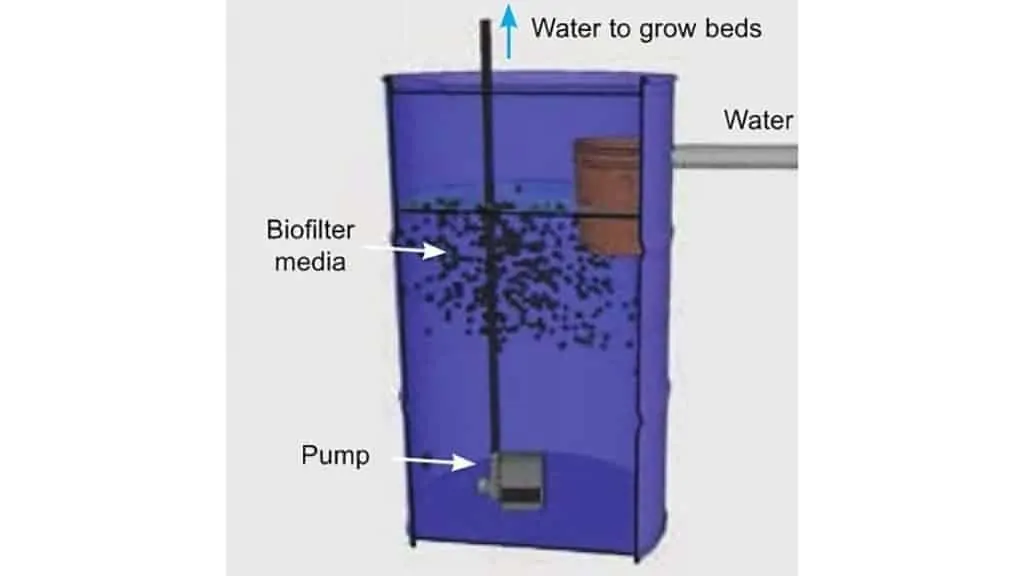
Sumps
A sump essentially is a lower reservoir area that will collect the unwanted liquids from the aquaponic system. Although aquaponic systems are not reliant on a sump or water reservoir, a sump may take the place of a biofilter, depending on the system. Usually, one of the two is used, or none at all. As with all containers of water, sumps should be opaque and covered. A sump is a useful component of an aquaponic system for several reasons:
- It increases the overall volume of the system, providing for more beneficial bacteria. This also allows a greater time-lag between mechanical issues and the system running dry, thus protecting it.
- It provides greater freedom when arranging to grow beds, as water can be directed to the sump as well as the fish tank.
- It allows for improved sediment filtration.

Hi, my name is Sean, and I’m the primary writer on the site. I’m blogging mostly about freshwater and saltwater aquariums, fish, invertebrates, and plants. I’m experienced in the fishkeeping hobby for many years. Over the years I have kept many tanks, and have recently begun getting more serious in wanting to become a professional aquarist. All my knowledge comes from experience and reading forums and a lot of informative sites. In pursuit of becoming a professional, I also want to inspire as many people as I can to pick up this hobby and keep the public interest growing.
Read more about Sean.
Please join also my Facebook group.

